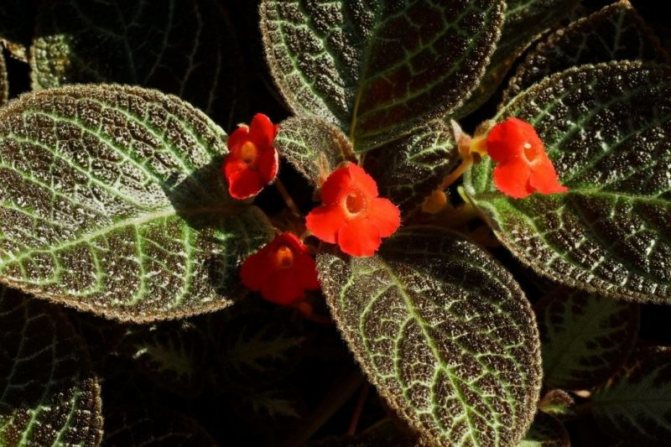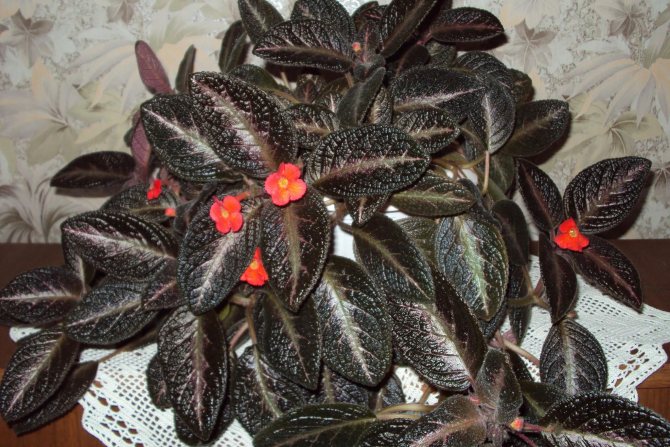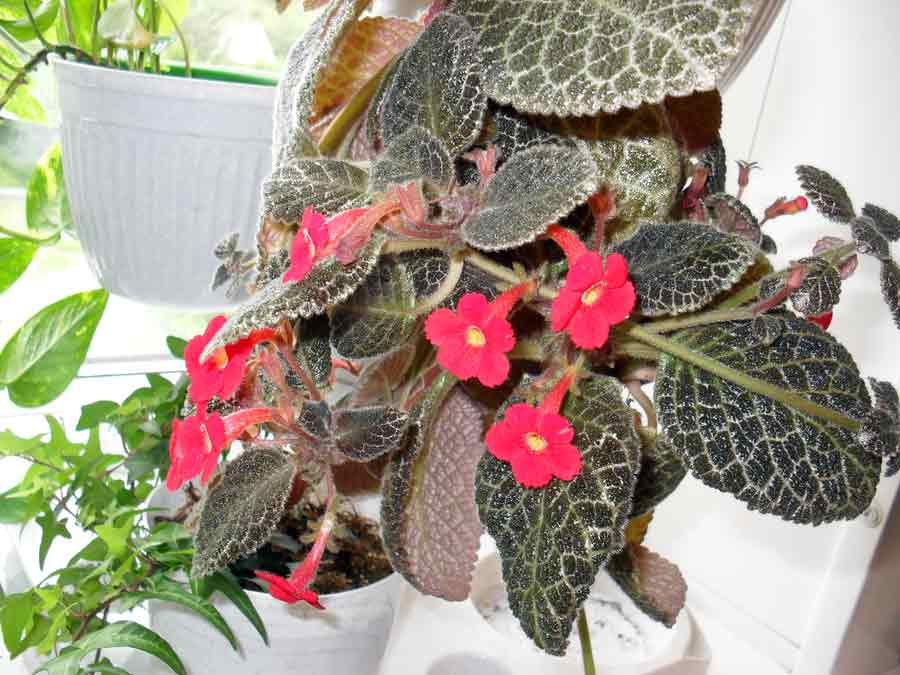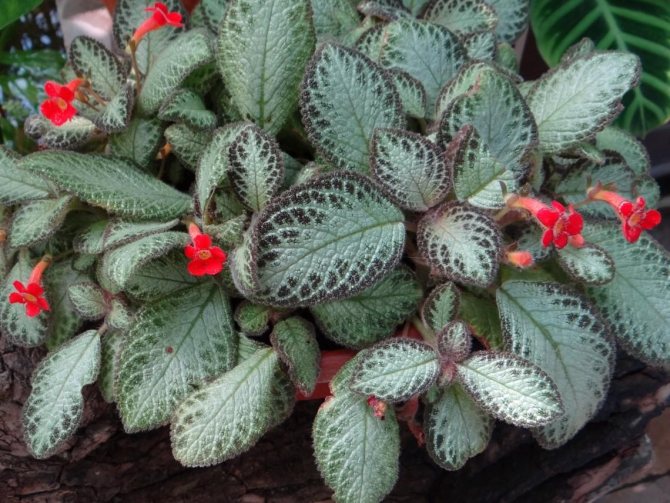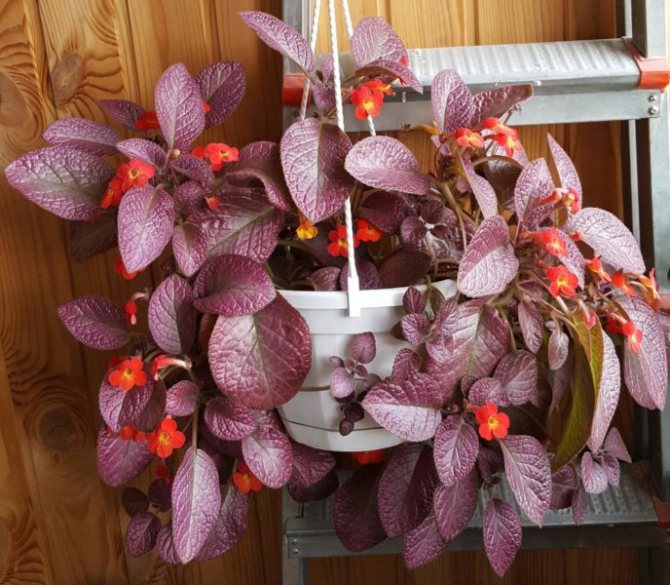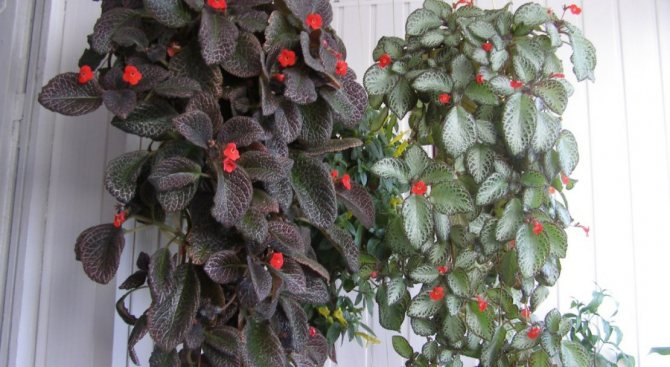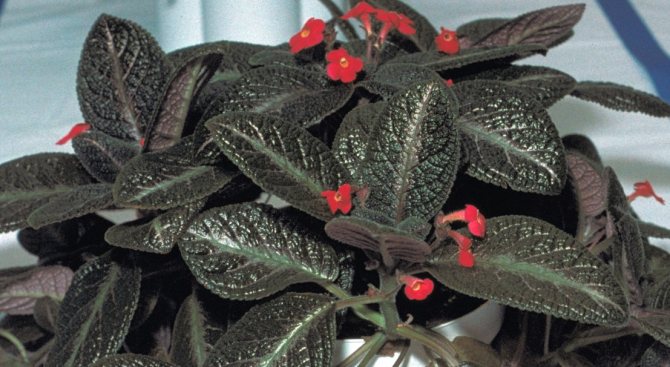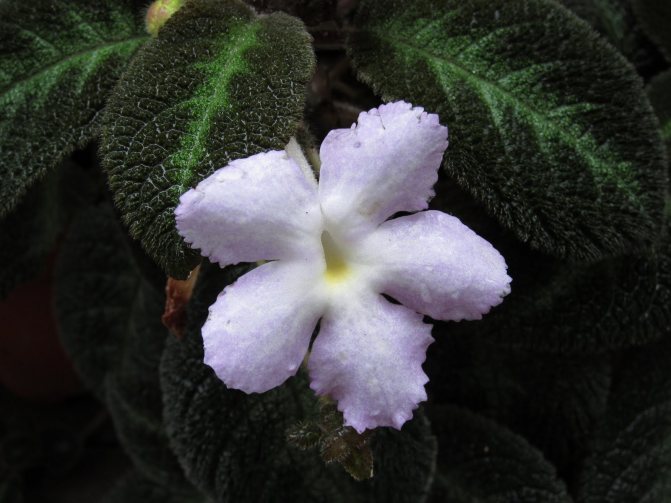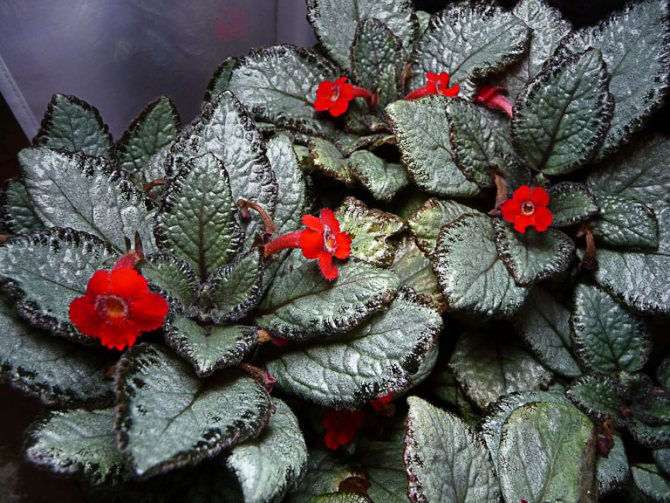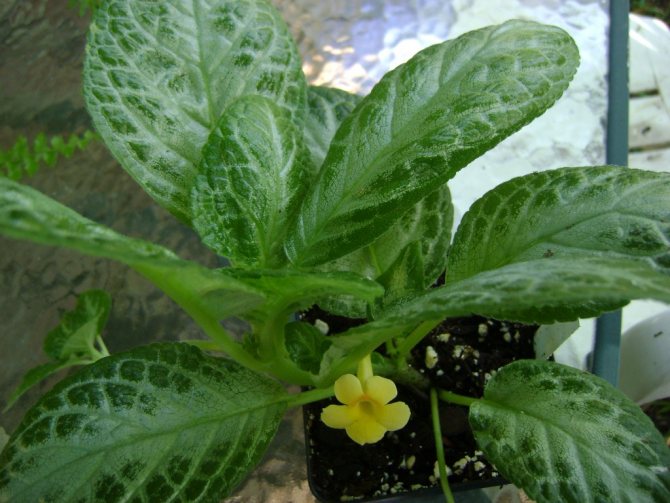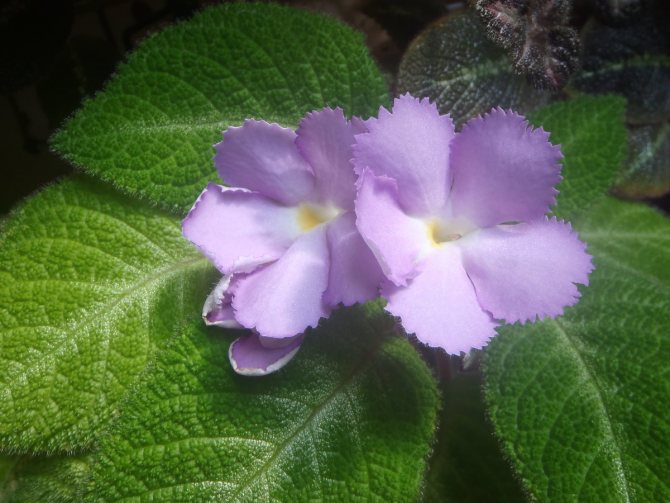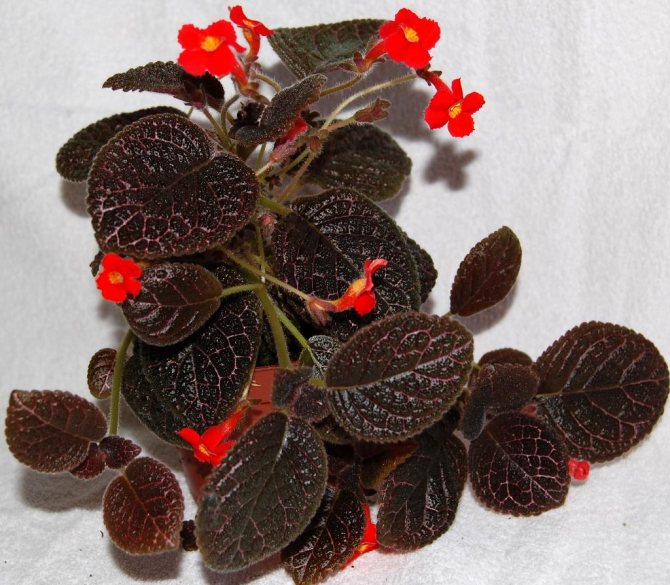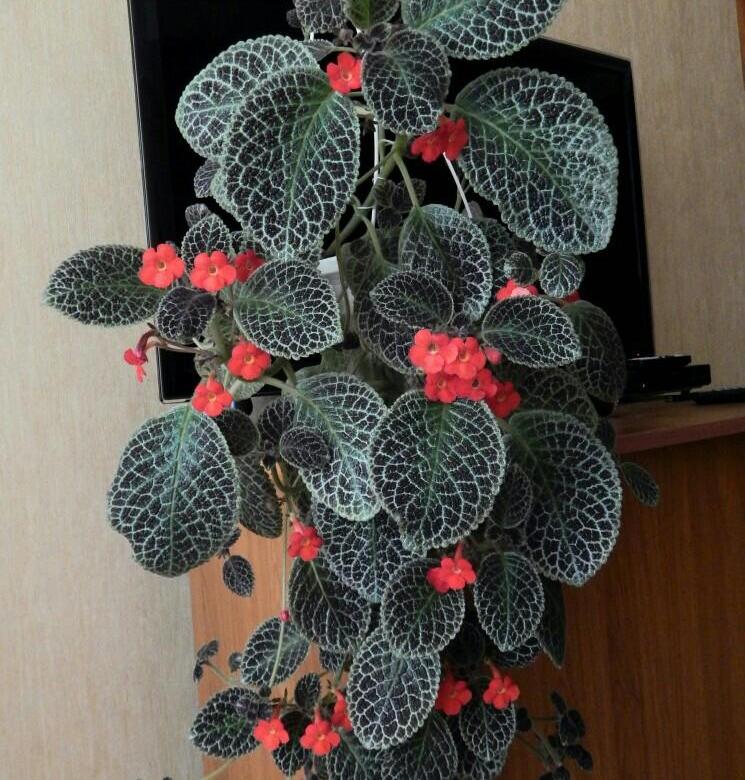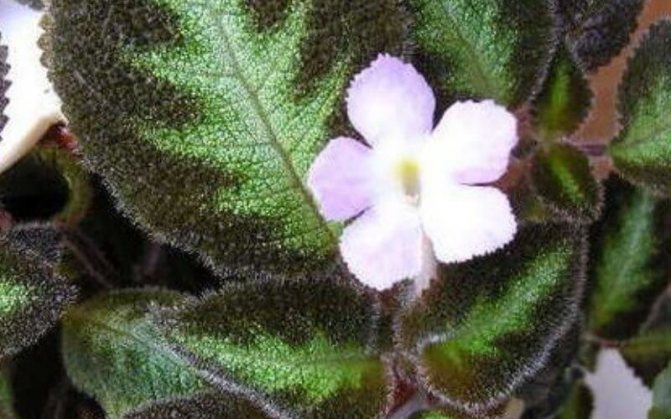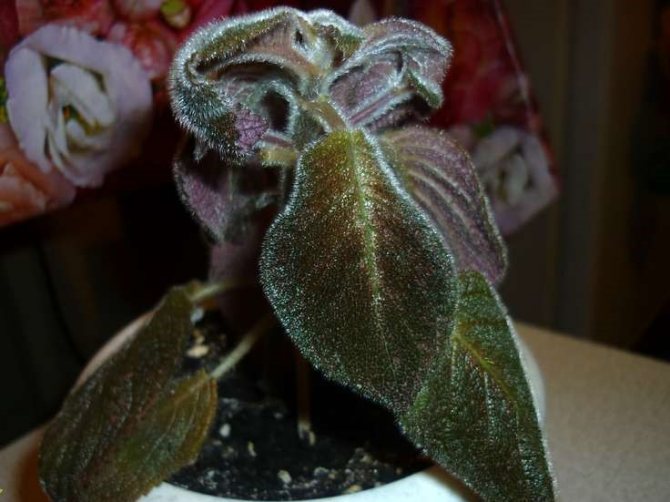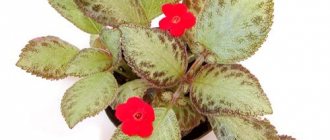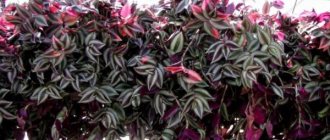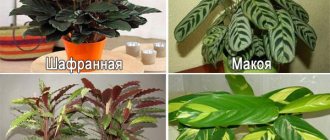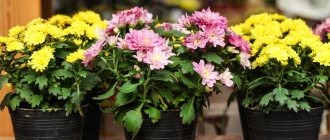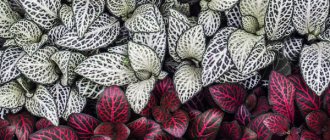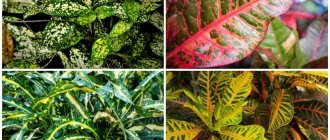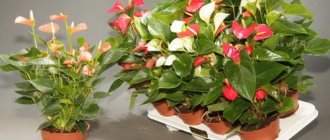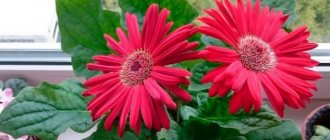
Luxurious indoor flower Episciya attracts attention with its unusual color and shape of leaves, which shimmer and change color. During flowering, the plant is covered with small bright flowers. In nature, the episode grows in the tropical forests of South America, the Antilles, Guinea and Suriname. The flower has a capricious disposition, so caring for an episode at home can cause some difficulties for novice florists.
Episation and its striking variety of species
Native to the tropics of Central and South America, Episkos from the genus Episcia belongs to the numerous Gesneriaceae family.
The plant's relatives are the well-known gloxinia, streptocarpus and saintpaulia. In the wild, the episode grows like a low-growing creeping grass. Indoors, it is grown in the form ampel plant.
Epicia has underground stems, which, as they grow, release shoots (whiskers) with formed rosettes of leaves. The rosettes, in turn, release their mustache with new rosettes, gradually forming a lush dangling crown in the form of a picturesque mosaic of leaves on the wall.
Through the efforts of breeders, about 100 new varieties of the episode have been bred. The leaves of each variety have their own unique color and unique pattern... You can find green, pink, brown, olive, burgundy and other shades of leaves.
Against the background of silvery leaves of the episode, bright lights sparkle of small flowers on a tubular stem, resembling in shape small gramophone with five delicate petals.
Depending on the variety, you can find red, bright scarlet, white, yellow, pink and speckled shades of flowers. Abundant flowering episodes begin in spring and end in autumn.
The genus Episcia is not numerous and includes less than 10 plant species. All varieties of episode are derived from three main types. Here are the most famous of the varieties:
- Episcia cupreata - velvety leaves with shades from light green pearlescent to dark copper with bright red, white or purple flowers.
- Episcia Silvans Beauty - smooth leaves, almost completely covered with a silvery pattern, with bright red flowers.
- Episcia Silver Sheen - silvery velvety leaves. framed with a green-brown border, with flowers of an orange-red hue.
- Episcia reptans - velvety leaves with shades from olive to black with a silvery pattern and red flowers.
- Episcia dianthiflora - green leaves with dark veins with snow-white flowers with lace fringes along the edges of the petals. A very effective variety!
Episcia Chocolate Soldier- greenish-brown leaves, painted with a bluish-silvery pattern, with red flowers growing several pieces on one peduncle. It is the most abundant variety.
Variety of species
Episode is very popular with florists. Currently, many hybrid varieties of this plant have been bred, differing in the color of leaves and flowers, the frequency and duration of flowering.... Among them, the following are worth highlighting:
- Silver shine. This type of episode has large, light green leaves covered with villi.An olive border is located along the edge of the leaf plate. The surface of the leaf is silvery with purple and brown blotches.
- Forest beauty. Silvery leaves are covered with pale light green veins. The flowers are bright scarlet.
- Episation is carnation. Leaves are medium-sized green with reddish-brown veins. The flowers have fringed edges, are painted white, outwardly resemble carnation flowers.
- Chocolate velor. Leaves are dense, medium in size. The leaf surface has dense pubescence and a brownish-violet pearlescent color. The leaves appear very soft and velvety in appearance. Home care for the description of this species is somewhat easier than for other species.
- Pink Panther. This hybrid variety has leaves with a wide pink border. The main color of the leaf is light green or silver.
Care and reproduction of red begonia at home
Features of the care of the episode
In order for the episode to please with active growth and abundant flowering, you cannot leave it unattended for a long time. AND it is important not to forget the most important thing - the plant categorically does not tolerate sudden changes in temperature, drafts and tobacco smoke.
Dust from Episode leaves is recommended clean with a dry brushnever using a damp cloth. Dry leaves should be removed from the plant bush in time.
Site selection and lighting
Ideal accommodation option episodes - a bright place shaded from active sunlight on the west or east window. In a room with southern windows, the plant should be placed next to the windowsill.
At the north window of light for an episode will not be enough... Experienced flower growers advise placing pots with a plant to the side of the window.
The most comfortable temperature for episode - from 18 to 25 ° C. At lower temperatures, it stops growing and can get sick.
Humidity and watering
In summer should water an episode soft water at room temperature, waiting for the top layer of the soil to dry. During watering, it is advisable not to get water on the leaves of the plant.
In winter time it is recommended to water episode two days after drying the top layer. The irrigation regime must be strictly monitored. The episodes are damaged by both excessive soil moisture and drought.
The plant needs in high humidity, but does not tolerate leaf spraying. Therefore, it is recommended to place it on a pallet with damp pebbles so that the bottom of the container does not touch the water.
The main rules for caring for calamondin at home - read our article.
Our material will tell you about the benefits of banana peel for indoor plants.
Transplant and feeding
The episode should be transplanted every spring in a low and wide pot. Transplant soil should be slightly acidic or neutral. The following mixture works well for this:
- 2 pieces of leafy land;
- 1 part of peat land;
- 1 part sand;
- some sphagnum and crushed charcoal.
It is also necessary to provide the plant with large drain holes in the bottom of the pot and a 2 or 3 cm thick drainage layer.
You should reload young plants once a month, without breaking the earthy ball, into a new pot with a diameter 2 or 3 cm larger than the previous one. The maximum pot size for an adult plant is approximately 20 cm in diameter.
Fertilizing the episode is recommended during the period of active growth twice a month with a weak solution of mineral or organic fertilizers. When preparing top dressing, the water should be twice the dose indicated in the instructions for fertilization.
Pruning and shaping the bush
The episode is growing rapidly, so you need to form its crown in a timely manner. Need to followso that its first shoots do not hang from the pots, otherwise they will begin to bare and injure themselves on the edge of the pot.
To prevent this from happening, when planting a plant, you need to insert a lattice about 20 cm high into the pot and attach young growing shoots to it. After filling the support with shoots, the trellis can be removed and the plant can be allowed to grow further downward freely.
Fast growing stems episodes, spreading, are able to take root in neighboring pots with plants. You need to monitor this and cut off too long shoots. Daughter rosettes from cut stems can be planted in the same pot, from which the episode bush will become even more magnificent and beautiful.
Reproduction
Episode reproduces in the following ways:
- Side shoots or whiskers. Developed shoots (whiskers) are rooted in water and, after the roots appear, are planted in the ground.
- Daughter sockets. Young rosettes, without separating from the mother plant, are deepened into the ground and rooted. After rooting, the young plant, having separated, is planted in a new pot or planted with the mother plant. The first roots of shoots usually appear within a week.
- Stem cuttings. Cut cuttings are planted in the ground and covered with glass. Within a week, the stalk takes root.
- Seeds. This method contributes to the loss of varietal characteristics of the plant. Seeds are planted superficially, without sprinkling with earth, in a "greenhouse" and maintaining the temperature at least 20 ° C. Seedlings appear in 10 - 14 days. After three weeks, the seedlings dive.
A master class on reproduction of an episode with a mustache, watch the video:
Signs and superstitions


It is believed that the episode gives a person good potential, the joy of creativity, spreads life force around.
This baby looks especially good in the kitchen., where after a hard day the family gathers for gatherings, and in the office, contributing to a burst of imagination. By giving someone an episode, you help them find mutual love and strengthen their marriage.
Pests and common problems
Dangerous insects for an episode, it is a mealybug, aphid, root nematode. If pests are found, the plant should be treated and the soil should be shed with insecticides (Actellik and Neoron). It is recommended to repeat the treatment, taking a break of 10 days.
On defeat root nematode you need to cut the cuttings from the plant and grow new healthy episodes from them. Diseased roots should be discarded, and the container should be disinfected.
- The plant does not bloom - insufficient watering, excess nitrogen in fertilizer, dry air, cool room, lack of light.
- Gray bloom on the leaves - stuffy room, old soil or waterlogging.
- Leaves turn yellow - an excess of fertilizers, direct sunlight, dry air.
- Brown spots on the leaves - cold water for irrigation.
- Slow growth - lack of light.
- Leaves and buds curl and dry - dry air.
- Leaves turn yellow and rot - excessive watering.
For tips from home care professionals and common problems with indoor flowers episodes, see the video below:
Certainly delightful episode requires a lot of attention and care. But having carefully studied all the intricacies of caring for her, you can grow a real flower miracle in your home greenhouse. For her tireless care, the exquisite beauty will certainly thank you with silvery luxury of leaves and a bouquet of bright flowers.
Home care
The plant is considered to be very moody, however, it is very simple to care for an episode flower at home. To do this, it is enough to strictly follow some rules and recommendations of experienced florists.
Lighting and location
For the indoor flower of the episode, you should choose the right lighting and temperature conditions.
The flower requires bright, but diffused lighting. The plant does not tolerate direct sunlight.Episation grows well in slightly shaded rooms.
In order for the plant to retain its shape, it is not recommended to often rearrange it to a new place or turn the pot. In order for young shoots to form correctly along the edges of the pot, it is recommended to install a mesh, which is removed when the stems are long enough.
In winter, the flower will require additional lighting, so additional lighting with fluorescent lamps should be used.
Watering and moisture
Warm filtered water is used for irrigation. Watering is carried out regularly. Do not allow the soil to dry out. With irregular watering, the growth of the plant slows down, the leaves lose their attractive color. Watering should be carried out strictly at the root., since when it comes into contact with pubescent leaves, their surface can become covered with brown spots. In winter, the plant is watered once every few days when the top soil layer dries up.
Avoid the accumulation of moisture in the pallets, as this can cause the root system to get wet. The drain holes should be cleaned periodically. This measure will also help prevent the accumulation of excess moisture in the soil.
Ripsalidopsis flower care at home
For an episode, humidified air is required, this is especially important if the plant is located near heating appliances. Episode must not be sprayed. To increase the air humidity, you can use a humidifier or place a flower pot in a tray with moistened expanded clay.
Description
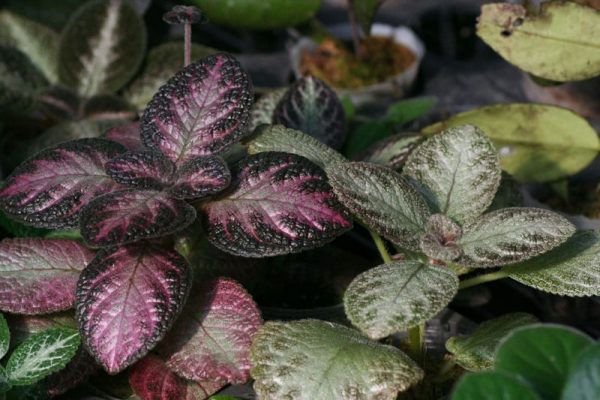

Episodes are prized for their decorative leaves.
Episia is a plant of the Gesneriaceae family. The name comes from the Greek "episkios", which means "shaded", "dark". The homeland of the plant is the tropical forests of Brazil, Guinea, Mexico, Colombia, Antilles, Suriname. The flower prefers shady wet places, spreads along the ground.
It has pubescent oval leaves reaching 5-20 cm in length. They are variegated in brown-pink-green-olive colors. The plant does not shed old leaves for a long time, therefore, no exposure of the trunk is observed. In home cultivation, the episode is an ampelous plant. Young shoots can grow vertically, but then fall down. Usually adult plants reach 40-60 cm in length.
Episode is mainly grown for foliage, although the plant is flowering. Variegated phonographs about 3 cm long are more often scarlet, but there are also white, pink, even speckled flowers. They stay on the plant from June-July to September, but there are also early varieties.
Episode varieties
There are many varieties of episode. Each has a unique leaf pattern and color. All of them are derived from three main types:
- Episation carnation combines long whiskers and shortened shoots with closely spaced leaves. Dark green leaves 3 cm long in the center have a purple vein, densely pubescent. Single white flowers with fringed edges resemble carnations.
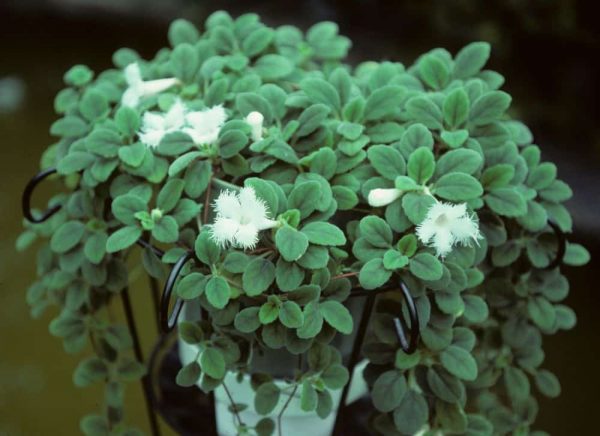

One of the varieties of clove-leaved episode.


A view of the copper inscription.
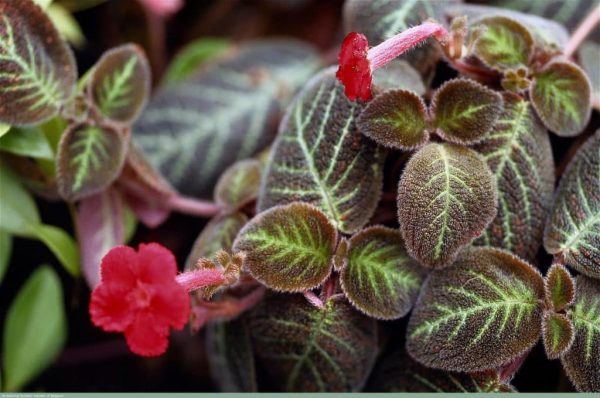

Type of creeping episode.
Conditions for growing episodes
Episation does not require painstaking care, so even a novice florist can cope with its cultivation.
Seat selection
Episation grows best on east and west windows. When placed on a sunny windowsill, additional shading is required, otherwise the leaves will dry and curl, lose color, the plant will slow down in growth. Ampel varieties, when kept on windowsills, can sprout into neighboring pots and take root in that soil. To avoid this, the episodes can be hung in the planter.
Throughout the year, the optimum temperature for a plant is 22-24 ° C. Lowering it to 16 degrees can be detrimental to the flower. The increase is not so critical with sufficient soil moisture.
Humidity and watering
In the spring and summer, the episode is watered on average once every 2-4 days, while preventing excessive soil moisture. In winter, reduce watering to 1-2 times a week. In general, they look at the top layer of the soil - when it is dry, the plant is watered. The accumulation of water in the sump must not be allowed.
The flower loves moisture, but it is not necessary to spray densely pubescent leaves. Also, do not get on the leaf plate when watering. This can cause unsightly stains. For additional moistening, containers with water or wet expanded clay, pebbles are placed next to the pot.
Soil and transplant
The soil should be light, air and moisture permeable, with an acidity of 5.5 pH. Optimal composition: 2 parts of leafy soil, 2 parts of low peat, 1 part of sphagnum moss. From purchased soils for episodes, universal and intended for Saintpaulias are suitable. You can add charcoal and sphagnum to it.
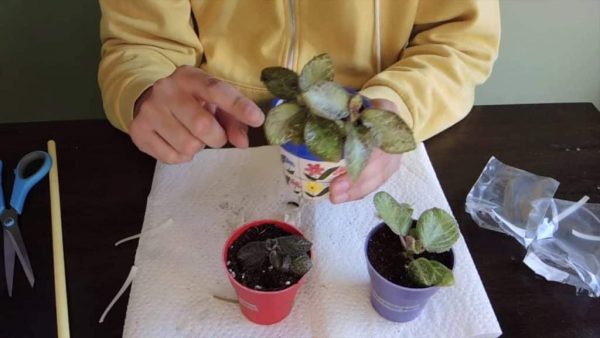

Epixia transplant is carried out 1-2 times a year.
Transplantation of young plants is carried out twice a year - in spring and autumn, once is enough for adults. Choose a wide container with drainage holes. At the bottom of the pot, drainage must be laid with a layer of 3 cm.The flower grows quickly, so the new container should be 4-5 cm wider than the previous one.
Half an hour before transplanting, the plant is watered abundantly. After carefully removing from the pot, examine the roots, remove dry and rotten ones 3 cm above the damaged area, sprinkle the sections with gray. After transplanting into a new pot, the episode is watered abundantly, after half an hour, removing excess water from the pan. The first week the plant is kept in partial shade.
Fertilization
Episode is fed in the spring-summer period once every 2 weeks. Fertilizer is used for flowering plants, which is applied exclusively to moist soil. It is diluted in a concentration that is 2 times weaker than that recommended on the package. Caution: when adding top dressing to overdried soil, it is easy to damage the root system.
Pruning
The episode is periodically pruned to give a beautiful shape, because the plant grows quickly. This is done with disinfected scissors or a knife after the end of the flowering period. Cut off shoots can be rooted and planted in the same pot to make the bush more lush.
In order not to violate the correctness of the form, it is not recommended to rearrange the description to another place, turn the pot. To prevent injury to the first and new shoots on the edges of the pot, a mesh is installed in the soil. When the shoots grow long enough, it is carefully removed and the branches of the plant hang over the edges.
Top dressing and fertilizers
The episode needs periodic fertilizing with mineral fertilizers. For this, ready-made complex compositions for violets or flowering ornamental plants are suitable.
The main varieties of hybrid tea roses and their cultivation
Fertilization is carried out in the summer every 10-15 days. Fertilizers should only be applied to wet soil in a weaker concentration.
Flowering period
Depending on the species, the episode blooms in June or July and ends in September. There are varieties that bloom from April to October. Flowers are solitary, in the form of gramophones. In diameter, they usually reach 3-5 cm. Red shades are more common, but there are also yellow, blue, white, speckled variations. Withering flowers and leaves should be removed immediately so that the plant wastes less energy. There is no data on the development of allergic reactions during the flowering period.


Beautiful flowering episode.
Episode does not bloom
If the episode does not bloom, this indicates the wrong conditions of detention. Any mistakes can lead to a lack of flowering. Mostly:
- Frequent overdrying of the soil.
- Dry or cold indoor air.
- Frequent application of nitrogen fertilizers and a lack of potassium-phosphorus fertilizers.
- Lack of lighting.
Growing difficulties
The episode is rarely affected by pests. These are mainly mealybugs, aphids, root nematodes.If the latter is defeated, it is necessary to cut and root healthy cuttings, and destroy the pot with the old soil. The rest of the pests are fought by treating the plant with insecticidal preparations (Aktellik, Fitoverm, Aktara).
Episode diseases
The plant is often affected by putrefactive diseases caused by excessive watering, kept in a cold room. When the root system is damaged, the plant is sluggish, the leaves are soft, wrinkled, although the soil is moist. You can save the flower by transplanting it into dry soil.
But if the roots do not work at all, only re-rooting of the cuttings will help. To do this, the shoots are cut 3 cm above the rotten tissue and set to take root. To prevent rot, you need to regulate watering, ensure that there are holes in the bottom of the pot and a layer of drainage.
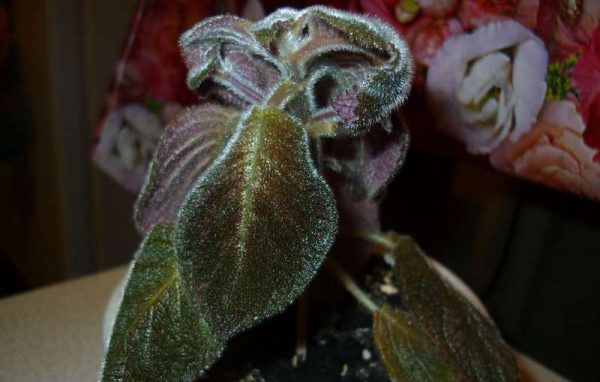

Decay of the root system of the episode.
Sometimes powdery mildew affects the plant. A white powdery coating appears on the stems and leaves. May occur due to keeping in a poorly ventilated room, growing in old soil. To combat it, fungicides are used - "Topaz", "Quadris" and others.
Other problems
More often, the owners of the episode are faced with the following problems:
- The appearance of brown spots on the leaves due to the ingress of water.
- Yellowing of leaves due to sunlight, excess fertilizer, low humidity.
- Drying of the tips of the leaves, weak growth of new shoots due to too dry indoor air.
- Leaves curl due to irregular watering.
- The leaf plate becomes smaller, loses color when there is a lack of lighting.
Diseases and prevention measures: why a plant can be ill
Healthy episodes rarely get sick. However, they can become infected from other indoor plants. The most dangerous are aphids, mealybugs, and root nematodes.
Diseases and preventive measures - table
| Pest / disease | Symptoms of defeat | Prophylaxis | Treatment |
| Aphid | Prefers to settle on buds, shoots and leaves. The insect feeds on the sap of the plant, the leaves wither and curl up, the shoots dry up. |
|
|
| Scorms | White lumps, similar to cotton wool, form on the foliage. Sucking insects inhibit the growth of the plant, cause yellowing and drying of leaves, the formation of a gray coating on them. |
|
|
| Nematodes | Roundworms violate the integrity of the roots, leading to their death. infected plants do not grow well, the leaves begin to curl. |
|
|
| Root rot | The fungus disperses in a humid environment. Leaves wither. The roots become soft, gradually rot. |
|
|
Reproduction
Episode can be propagated by seeds, cuttings, side shoots or daughter rosettes, leaves. When propagated by seeds, the properties of the mother plant are almost always lost, so the method is not relevant.
- Developed lateral shoots are separated from the mother plant and planted in the ground. They are looked after as if they were an adult episode.
- When rosettes appear on the layers, they are placed in the ground, without separating them from the mother plant. Once they are rooted, they can be neatly separated and planted in a separate pot, or planted in an adult episode.
- When propagated by stem cuttings, they are rooted in water or immediately in the ground. When rooting in the soil, the cutting is covered with a transparent container on top, creating a greenhouse. They are kept in a warm, bright place - the temperature of the soil should be at least 18 degrees. When the roots appear, you can transplant the cutting into a permanent pot.
This is how leaf rooting occurs.

